LEARN ABOUT OHEKA CASTLEA RICH AND VIBRANT HISTORY
Celebrating 100 Years of History from 1919 to 2019
A century ago, financier and philanthropist Otto Hermann Kahn built OHEKA CASTLE in the middle of a 443-acre plot on the highest point on Long Island in Cold Spring Harbor for an estimated cost of $11 million ($158 million in today’s currency). At the time of its construction, the French-style chateau was—and still is today—the second-largest private residence ever built in America. During the Gilded Age of the 1920s, Kahn used the 109,000-square-foot, 127-room estate as a summer home where he hosted lavish parties and regularly entertained royalty, heads of state, and Hollywood stars.
After Otto Kahn died in 1934, the estate changed hands several times, serving as a retreat for New York sanitation workers and a government training school for Merchant Marine radio operators. In 1948, the Eastern Military Academy bought OHEKA, bulldozed the gardens, subdivided the rooms, and painted over the walls. After the school went bankrupt 40 years later, OHEKA stood abandoned, except by vandals who set numerous fires over five years. In 1984, developer Gary Melius purchased OHEKA and the remaining 22 acres that surrounded the estate and began the painstaking challenge of restoring the Castle to its original grandeur.
Intent on preserving the authenticity of OHEKA, architects, historians, and researchers were brought in to corroborate every detail. Slate roof tiles, used in the two-year restoration of the roof, were sourced from the same Vermont quarry where Kahn had purchased the originals. More than 222 windows and doors were replaced with custom-made duplicates. The handcrafted wrought-iron railing on the Grand Staircase took two months to be refurbished. Faux Bois specialists were brought in to restore the walls in the Library and rubber castings were made to restore the beautiful plaster mouldings in the Ballroom and the Library. The Formal Gardens were recreated using original drawings from The Olmsted Brothers, resurrecting the eight reflecting pools and three fountains.
Today, after $40 million in restoration, the largest in American History, OHEKA CASTLE is listed on the National Register of Historic Places and is a member of Historic Hotels of America®, the official program of the National Trust for Historic Preservation for recognizing and celebrating the finest historic hotels across America, and Historic Hotels Worldwide®, which is dedicated to promoting heritage and cultural travel to prestigious historic treasures. The Castle has earned the reputation as one of the most recognized prestigious wedding venues in the world and has been the backdrop to many notable movie and TV productions, from the making of the classic film Citizen Kane, including Royal Pains and the more recent TV series, Succession.
OHEKA Timeline

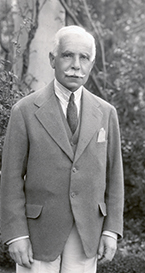
- Otto Hermann Kahn purchased 443 acres of land in Cold Spring Harbor for 1 million dollars where OHEKA was to be built.
- 2 years were spent building the hill on which the estate was to be built, making it the highest point on Long Island.

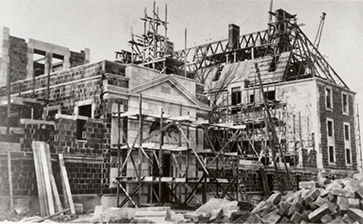
- Construction began.
- Architects: Delano & Aldrich (one of the Gold Coast's premier mansion builders).
- Landscape Architect and Gardener Beatrix Farrand was commissioned by the Olmsted Brothers to design aspects of the Formal Gardens.
- Ironwork: Designed by Samuel Yellin

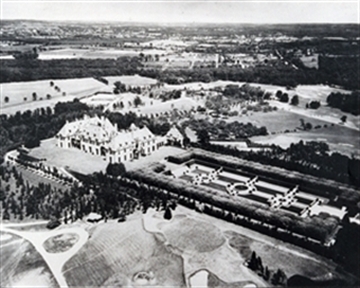
- The building of OHEKA was complete.
- The original cost to build OHEKA was $11 million ($158 million in today’s currency).
- Architects: Delano & Aldrich (one of the Gold Coast’s premier mansion builders).
- Landscape Architects: Olmsted Brothers (firm established by Frederick Law Olmsted, architect of New York City’s Central Park).
- Otto Hermann Kahn, his wife Addie, and 4 children used OHEKA as their summer home and weekend retreat.
- The name “OHEKA” is an acronym for Otto HErmann KAhn.
- The Kahn Family Motto was "Ever Restlessly Forward."
- The Cold Spring Country Club was once the original horse stable and the golf course was once part of the original 443 acre estate.
- At 109,000 square feet, OHEKA was and remains the second largest private home in America (only the Biltmore in North Carolina can boast grander dimensions).
- Construction: Reinforced steel and concrete with some walls 2’6” thick.
- OHEKA originally consisted of 127 Rooms.
- 126 full-time servants were originally employed by Otto Kahn.
- A total of 39 working fireplaces existed throughout the estate.
- The Grand Staircase in the Entry Foyer was inspired by the famous exterior staircase from the Chateau de Fountainebleau in France.
- The Ballroom is 72’6” x 32’5” with a 24’ ceiling height.
- The Formal Dining Room is 51’6” x 30’2” with an 18’ ceiling height.
- Otto Kahn’s fear of fire prompted him to use fireproof materials in OHEKA and to paint the plaster walls in the Grand Library using a technique developed in the middle-ages, called "faux bois" which gives the plaster walls the warmth and grain of fine wood paneling.
- The Library once had a secret passageway hidden in one of the bookcases which led into a small chamber referred to as his secretary’s office.
- The emblem of “The Linden Tree” seen throughout the estate was the symbol of Kahn’s hometown in Germany.

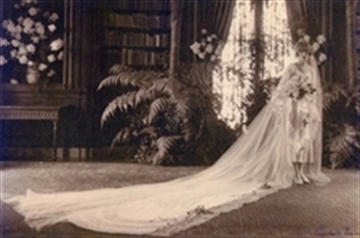
- Otto Kahn's daughter, Maud, marries on June 15, 1920, and becomes OHEKA's first bride.

- Otto Kahn died of a heart attack.

- The image of Otto Kahn is used as the inspiration for the character "Mr. Monopoly."

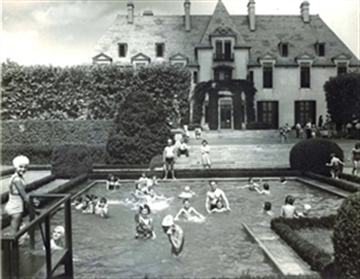
- The family sold OHEKA to the Welfare Fund of the Sanitation Workers and the estate became a retirement home for the sanitation workers of New York City. They re-named OHEKA “Sanita."

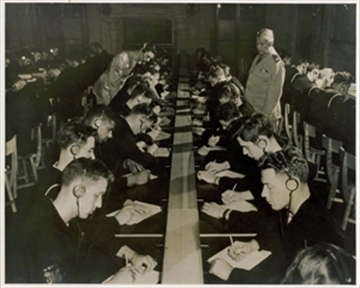
- OHEKA became a radio operator's school for the Merchant Marines.

- The greenhouses were sold to the Otto Keil family and are now known as The Otto Keil Florists.

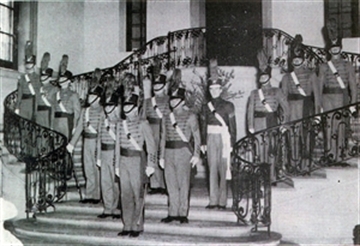
- OHEKA was owned and occupied by the Eastern Military Academy.

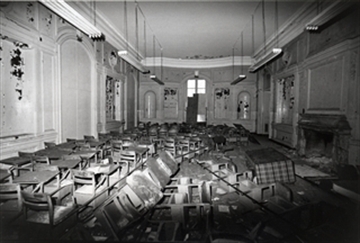
- OHEKA was abandoned and fell into almost total disrepair.

- The Cold Spring Hills Civic Association consisting of residents of Cold Spring Hills sought to preserve OHEKA.

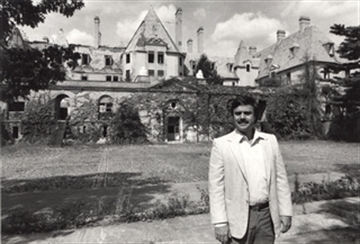
- Gary Melius, a Long Island developer, purchased the devastated estate of OHEKA which had no electric, plumbing, windows or doors, and its 22 remaining acres, for 1.5 million dollars.

- A total of 300 - 30 yard containers (9000 yards) were used to discard all the debris. Restoration began to restore the estate to its original grandeur.

- A total of 222 windows and doors were installed to seal and protect the estate.

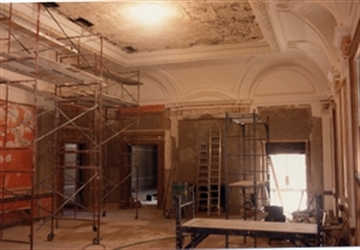
- 4000 roof slates were purchased to restore the damaged roof from Rising & Nelson Slate Co., the same Vermont Quarry used by the Kahn family.
- OHEKA CASTLE becomes a Wedding Venue and hosts its first wedding on May 7, 1987.

- The Friends of OHEKA, a not-for-profit corporation, was formed by community members of Cold Spring Hills and Huntington to protect, preserve and raise public awareness of OHEKA.

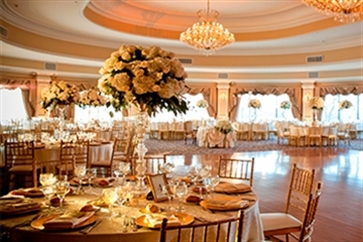
- The Terrace Room was added to the Estate to accommodate larger events. With the addition of the Terrace Room, OHEKA, currently 115,000 square feet, comprises 117 rooms and 50 baths.

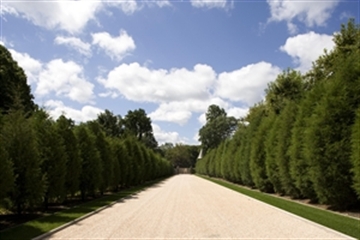
- 500 Red Cedars were planted and now line West Gate Drive leading to the courtyard to further restore the estate to its original design.

- 44 London Plane trees were planted in the Formal Gardens to replace the missing trees that existed in the original design.
- 2,505 Boxwoods were planted around the reflecting pools to further restore the Formal Gardens to its original design.
- 259 new windows and doors from Italy began being installed throughout the estate.

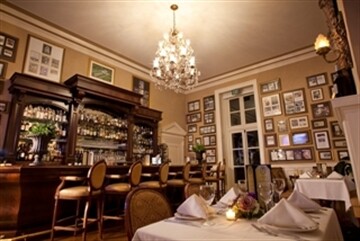
- The OHEKA Bar & Restaurant opened to the public.

- The Bar & Restaurant is officially re-named OHK Bar & Restaurant. The logo is inspired by an original logo created by Otto H. Kahn in the 1920's.

- OHEKA CASTLE Commemorates 100 Years of History from Otto Kahn 1919 to Gary Melius 2019.

- Today: OHEKA is listed on the National Register of Historic Places and is a member of Historic Hotels of America®, the official program of the National Trust for Historic Preservation for recognizing and celebrating the finest historic hotels across America. 85% of the estate and gardens have been fully restored.
- Future: Plans are to restore the remaining 15% of the estate into a Luxury Spa.

